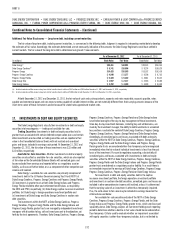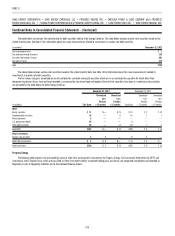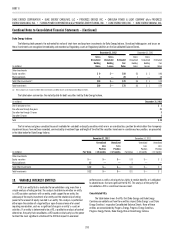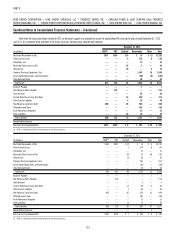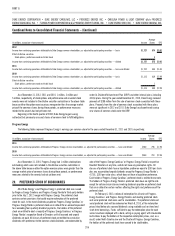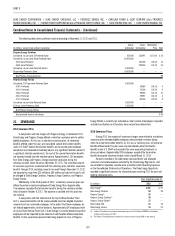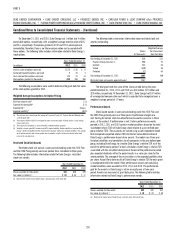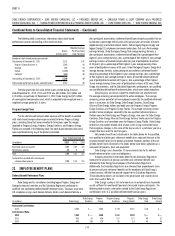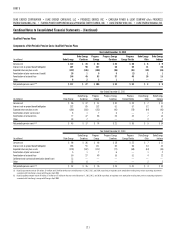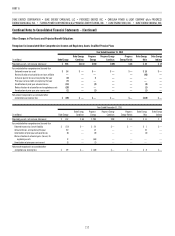Duke Energy 2012 Annual Report Download - page 222
Download and view the complete annual report
Please find page 222 of the 2012 Duke Energy annual report below. You can navigate through the pages in the report by either clicking on the pages listed below, or by using the keyword search tool below to find specific information within the annual report.
202
PART II
DUKE ENERGY CORPORATION • DUKE ENERGY CAROLINAS, LLC • PROGRESS ENERGY, INC. • CAROLINA POWER & LIGHT COMPANY d/b/a PROGRESS
ENERGY CAROLINAS, INC. • FLORIDA POWER CORPORATION d/b/a PROGRESS ENERY FLORIDA, INC. • DUKE ENERGY OHIO, INC. • DUKE ENERGY INDIANA, INC.
Combined Notes to Consolidated Financial Statements – (Continued)
DERF.
Duke Energy Carolinas securitizes certain accounts receivable through
DERF, a bankruptcy remote, special purpose subsidiary. DERF is a wholly
owned limited liability company of Duke Energy Carolinas with a separate
legal existence from its parent, and its assets are not intended to be generally
available to creditors of Duke Energy Carolinas. As a result of the securitization,
on a daily basis Duke Energy Carolinas sells certain accounts receivable, arising
from the sale of electricity and/or related services as part of Duke Energy
Carolinas’ franchised electric business, to DERF. In order to fund its purchases
of accounts receivable, DERF has a $300 million secured credit facility with a
commercial paper conduit, which expires in August 2014. Duke Energy Carolinas
provides the servicing for the receivables (collecting and applying the cash to
the appropriate receivables). Duke Energy Carolinas’ borrowing under the credit
facility is limited to the amount of qualifi ed receivables sold, which has been
and is expected to be in excess of the amount borrowed, which is maintained
at $300 million. The debt is classifi ed as long-term since the facility has an
expiration date of greater than one year from the balance sheet date.
The obligations of DERF under the facility are non-recourse to Duke Energy
Carolinas. Duke Energy and its subsidiaries have no requirement to provide
liquidity, purchase assets of DERF or guarantee performance. DERF is considered
a VIE because the equity capitalization is insuffi cient to support its operations.
If defi ciencies in the net worth of DERF were to occur, those defi ciencies would
be cured through funding from Duke Energy Carolinas. In addition, the most
signifi cant activity of DERF relates to the decisions made with respect to the
management of delinquent receivables. Since those decisions are made by Duke
Energy Carolinas and any net worth defi ciencies of DERF would be cured through
funding from Duke Energy Carolinas, Duke Energy Carolinas consolidates DERF.
CRC.
CRC was formed in order to secure low cost fi nancing for Duke Energy
Ohio, including Duke Energy Kentucky, and Duke Energy Indiana. Duke Energy
Ohio and Duke Energy Indiana sell on a revolving basis at a discount, nearly
all of their customer accounts receivable and related collections to CRC.
The receivables which are sold are selected in order to avoid any signifi cant
concentration of credit risk and exclude delinquent receivables. The receivables
sold are securitized by CRC through a facility managed by two unrelated
third parties and the receivables are used as collateral for commercial paper
issued by the unrelated third parties. These loans provide the cash portion of
the proceeds paid by CRC to Duke Energy Ohio and Duke Energy Indiana. The
proceeds obtained by Duke Energy Ohio and Duke Energy Indiana from the
sales of receivables are cash and a subordinated note from CRC (subordinated
retained interest in the sold receivables) for a portion of the purchase price
(typically approximates 25 percent of the total proceeds). The amount borrowed
by CRC against these receivables is non-recourse to the general credit of Duke
Energy, and the associated cash collections from the accounts receivable sold
is the sole source of funds to satisfy the related debt obligation. Borrowing
is limited to approximately 75% of the transferred receivables. Losses on
collection in excess of the discount are fi rst absorbed by the equity of CRC
and next by the subordinated retained interests held by Duke Energy Ohio and
Duke Energy Indiana. The discount on the receivables refl ects interest expense
plus an allowance for bad debts net of a servicing fee charged by Duke Energy
Ohio and Duke Energy Indiana. Duke Energy Ohio and Duke Energy Indiana are
responsible for the servicing of the receivables (collecting and applying the cash
to the appropriate receivables). Depending on the experience with collections,
additional equity infusions to CRC may be required to be made by Duke Energy
in order to maintain a minimum equity balance of $3 million. There were no
infusions to CRC during the year ended December 31, 2012. For the years ended
December 31, 2011 and 2010, respectively, Duke Energy infused $6 million
and $10 million of equity to CRC to remedy net worth defi ciencies. The amount
borrowed fl uctuates based on the amount of receivables sold. The debt is short
term because the facility has an expiration date of less than one year from
the balance sheet date. The current expiration date is November 2013. CRC is
considered a VIE because the equity capitalization is insuffi cient to support its
operations, the power to direct the most signifi cant activities of the entity are
not performed by the equity holder, Cinergy, and defi ciencies in the net worth
of CRC are not funded by Cinergy, but by Duke Energy. The most signifi cant
activity of CRC relates to the decisions made with respect to the management of
delinquent receivables. These decisions, as well as the requirement to make up
defi ciencies in net worth, are made by Duke Energy and not by Duke Energy Ohio,
Duke Energy Kentucky or Duke Energy Indiana. Thus, Duke Energy consolidates
CRC. Duke Energy Ohio and Duke Energy Indiana do not consolidate CRC.
CinCap V.
CinCap V was created to fi nance and execute a power sale agreement
with Central Maine Power Company for approximately 35 MW of capacity and
energy. This agreement expires in 2016. CinCap V is considered a VIE because
the equity capitalization is insuffi cient to support its operations. As Duke Energy
has the power to direct the most signifi cant activities of the entity, which are
the decisions to hedge and fi nance the power sales agreement, CinCap V is
consolidated by Duke Energy.
Renewables.
Duke Energy’s renewable energy facilities include Green Frontier Windpower,
LLC, Top of The World Wind Energy LLC, Los Vientos Windpower1A LLC, Los
Vientos Windpower 1B, LLC and various solar projects, all subsidiaries of DEGS,
an indirect wholly owned subsidiary of Duke Energy.
Green Frontier Windpower, LLC, Top of the World Wind Energy, LLC and the
various solar projects are VIEs due to power purchase agreements with terms
that approximate the expected life of the projects. These fi xed price agreements
effectively transfer the commodity price risk to the buyer of the power. Duke
Energy has consolidated these entities since inception because the most
signifi cant activities that impact the economic performance of these renewable
energy facilities were the decisions associated with the siting, negotiation of
the purchase power agreement, engineering, procurement and construction,
and decisions associated with ongoing operations and maintenance related
activities, all of which were made solely by Duke Energy.
The debt held by these renewable energy facilities is non-recourse to
the general credit of Duke Energy. Duke Energy and its subsidiaries have no
requirement to provide liquidity or purchase the assets of these renewable energy
facilities. Duke Energy does not guarantee performance except for the production
tax credit guarantee mentioned above, an immaterial multi-purpose letter of credit
and various immaterial debt service reserve and operations and maintenance
reserve guarantees. The assets are restricted and they cannot be pledged as
collateral or sold to third parties without the prior approval of the debt holders.
Other.
Duke Energy has other VIEs with restricted assets and non-recourse debt.
As of December 31, 2011 these VIEs included certain on-site power generation
facilities which were sold in 2012. Duke Energy consolidated these particular
on-site power generation entities because Duke Energy had the power to direct
the majority of the most signifi cant activities, which, most notably involved
the oversight of operation and maintenance related activities that impact the
economic performance of these entities.


